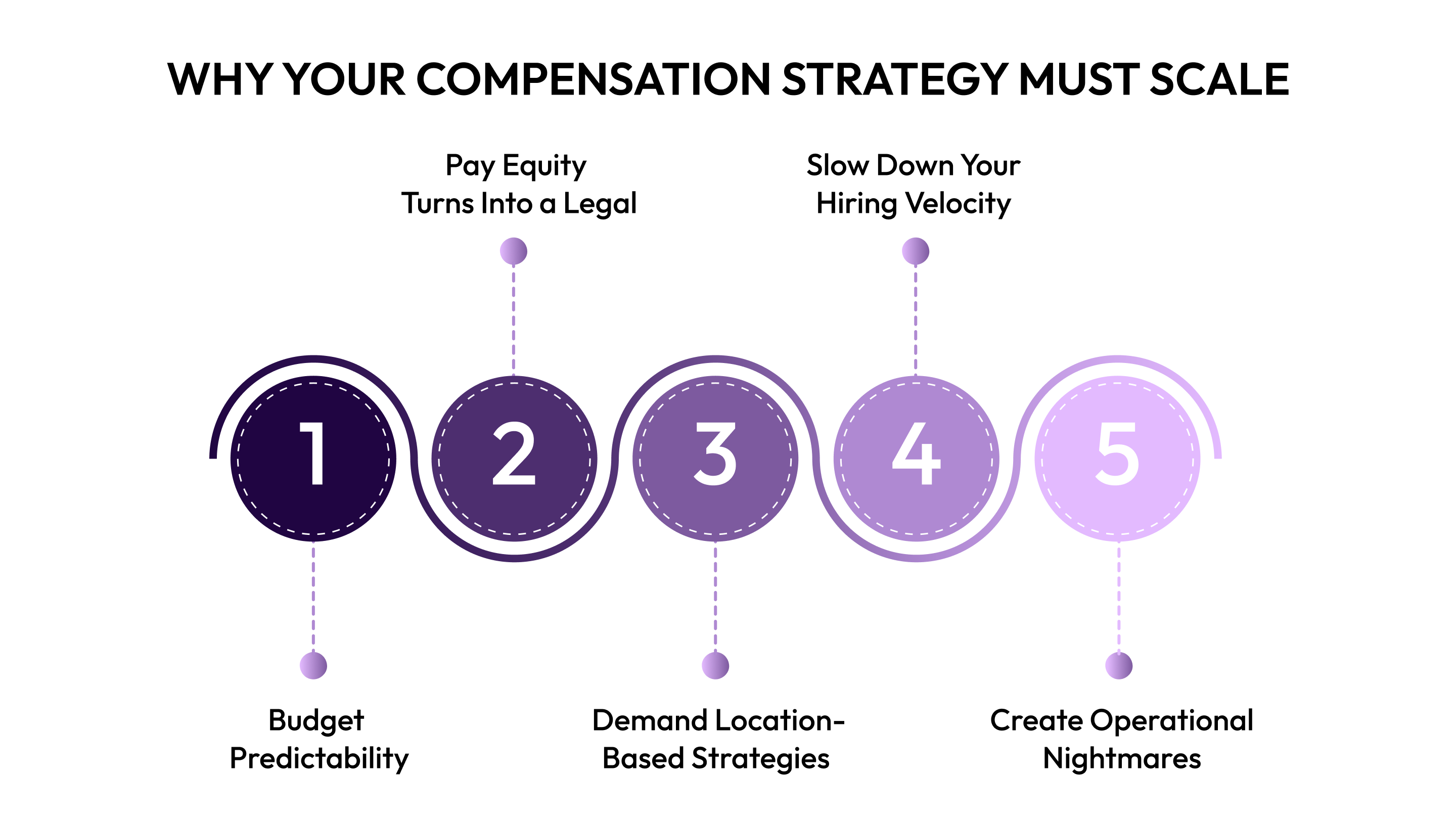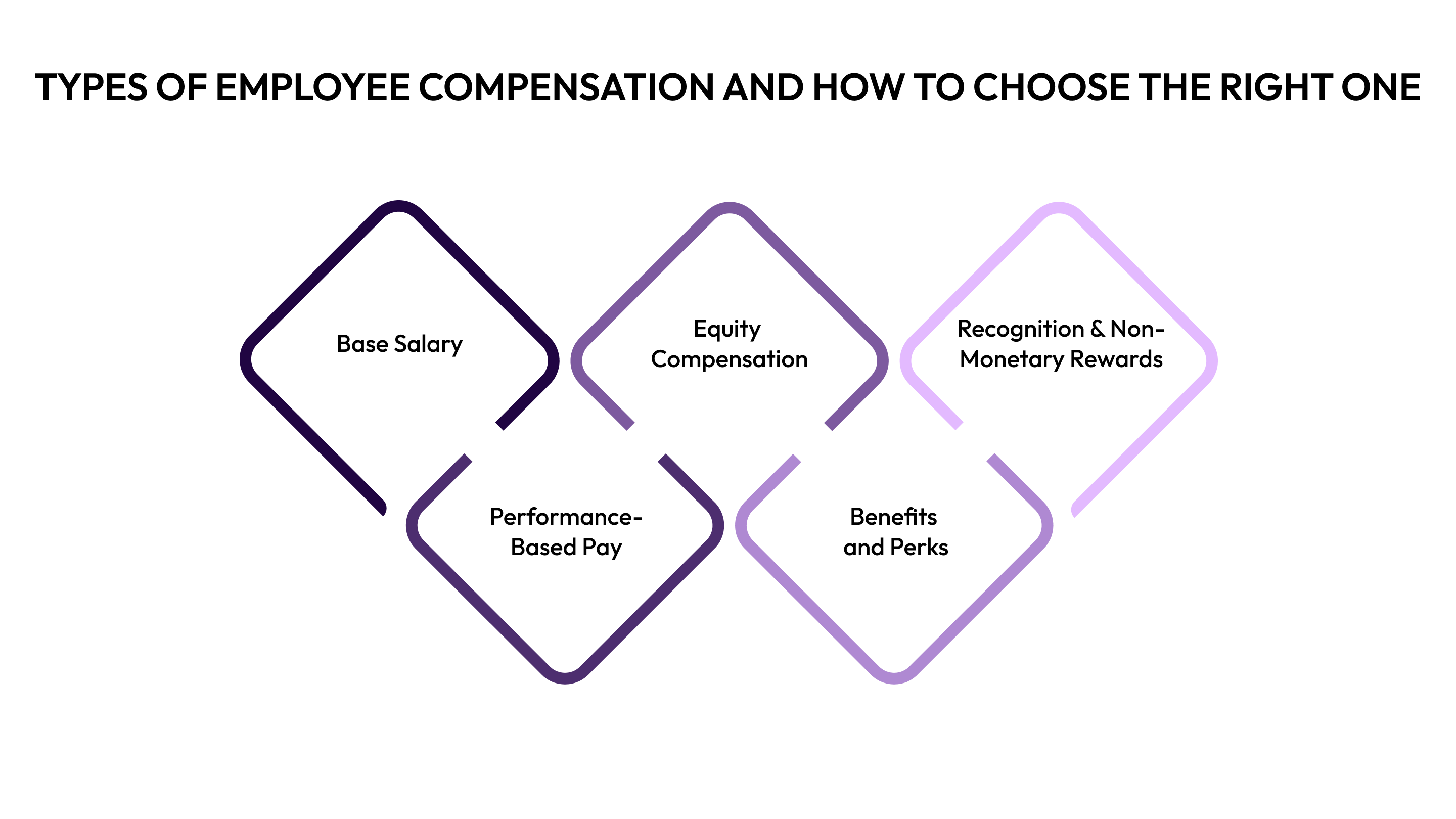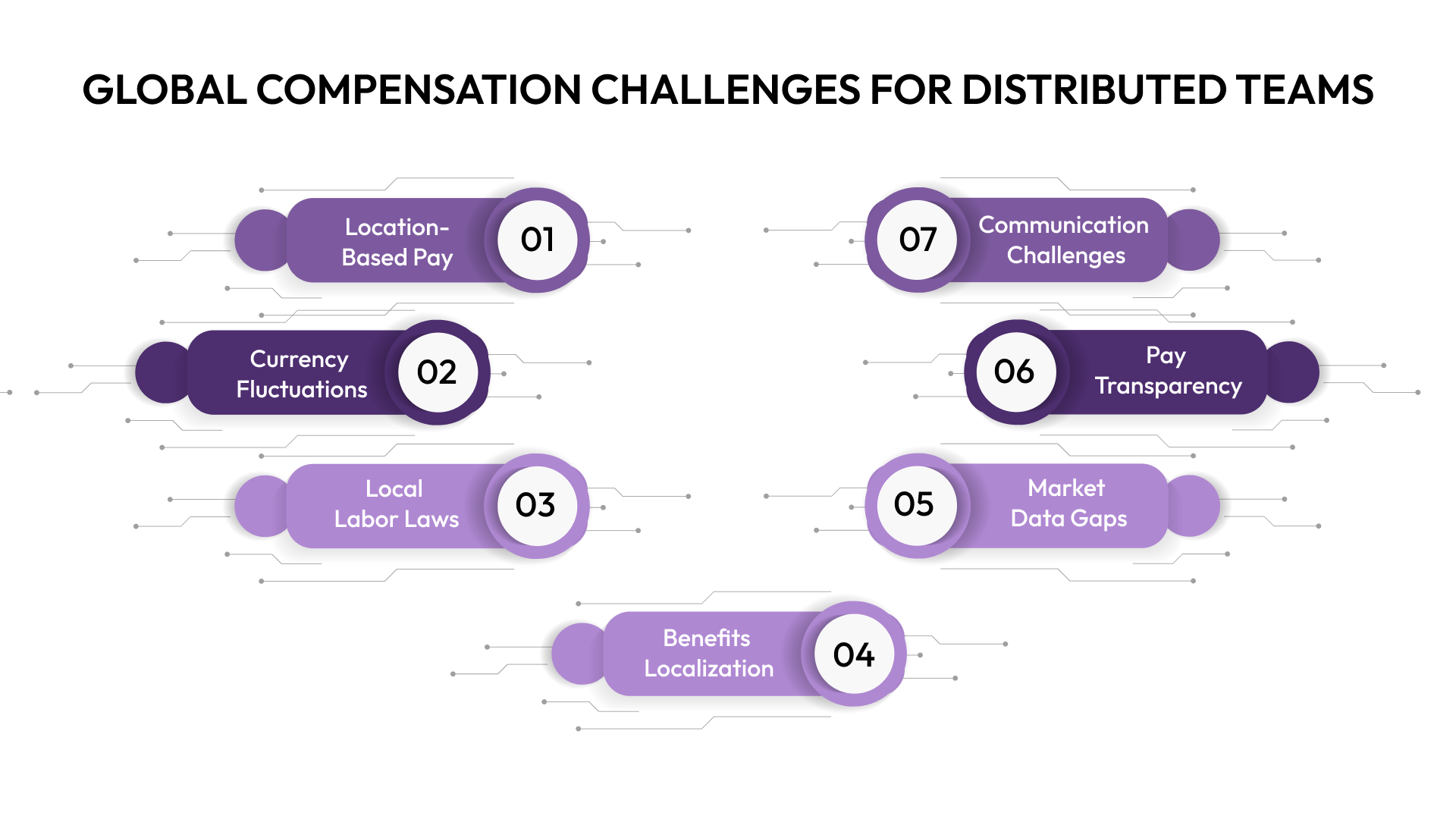Types of Employee Compensation Explained
Explore different types of compensation provided for the amount of work produced, including salary, bonuses, and benefits, to understand each option.

Your compensation strategy could be driving away your best talent right now, and you might not even know it! Mercer's August 2025 survey reveals that 52% of employers are scrambling to conduct pay equity studies to meet the demands for transparency. Yet, most scaling companies still manage compensation through disconnected spreadsheets and manual processes.
As you expand and hire distributed teams, every misstep in salary structure or bonus calculation creates retention risks and budget chaos. This guide breaks down each compensation type, helping you build a strategic framework that attracts top talent while maintaining budget control.
At a glance
- Compensation strategy becomes critical at scale: What works for 50 employees breaks at 200+. Without systematic frameworks, you risk budget chaos, pay equity issues, and losing top talent.
- Five compensation types to master: Base salary (your foundation), performance-based pay (for revenue roles), equity (for retention and startups), benefits (30-40% of total costs), and non-monetary rewards (high impact, low cost).
- Distributed teams add complexity: Global hiring means navigating location-based vs. role-based pay, currency fluctuations, varying labor laws, and localized benefits expectations across markets.
- Match compensation to your reality: Sales teams need variable pay, engineers want equity + solid base, and your growth stage dictates the cash-to-equity ratio that actually works.
- Common failure points: Ignoring pay equity early, designing comp without finance input, waiting too long to move from spreadsheets to proper systems, and not communicating total rewards value.
Why Your Compensation Strategy Must Scale

You've doubled your headcount in 18 months. Your finance team is drowning in compensation requests. Your top performers are asking questions about pay equity you can't answer with confidence. Sound familiar?
The ad-hoc approach that worked for your first 50 employees becomes a liability at 200. Scalable compensation isn't about creating bureaucracy; it's about building systems that grow with you, protect your budget, and keep your best people engaged.
Here’s why it matters:
1. Budget Predictability Becomes Non-Negotiable
With more employees, inconsistent compensation decisions create budget chaos. As of 2025, organizations with formal compensation strategies are in the majority, up from less than a third in 2020. Scalable frameworks let your finance team forecast labor costs accurately and prevent costly surprises that derail quarterly plans.
2. Pay Equity Turns Into a Legal and Retention Risk
Sharp salary increases in recent years have created serious pay compression and internal inequality issues that directly impact engagement and retention. Worse, 2025 is shaping up to be the year of pay transparency in the U.S., with five states implementing new laws and 10 more introducing legislation. Scalable systems enforce consistent pay bands and flag equity issues before they become legal problems.
3. Distributed Teams Demand Location-Based Strategies
Hiring across states or countries means navigating different cost-of-living benchmarks, tax implications, and market rates. Your compensation strategy needs to be built-in flexibility to pay competitively everywhere without overspending or underpaying.
4. Decision Bottlenecks Slow Down Your Hiring Velocity
Every compensation decision requiring three executives and a spreadsheet audit adds days to your hiring timeline. In competitive talent markets, delays cost you candidates. Scalable frameworks with clear guidelines empower hiring managers to move fast within budget guardrails.
5. Disconnected Systems Create Operational Nightmares
When compensation data lives across spreadsheets, HRIS platforms, and email threads, no one has a single source of truth. Presently, a lot of job postings still don't comply with pay transparency requirements, often because organizations lack centralized data. Scalable systems give every stakeholder real-time visibility without manual busywork.
However, there's no one-size-fits-all compensation playbook for scaling companies. Smart compensation design mixes the right components to attract talent, align incentives, and stay within budget.
For a deeper dive into benchmarking methodology and data sources, see our guide to compensation benchmarking.
.png)
Types of Employee Compensation and How to Choose the Right One

Your sales team needs different motivators than your engineering team. Your Series A startup can't compete with Google's cash packages, but you can offer equity upside they can't match.
Let's break down each compensation type and when it makes sense for your growing organization:
1. Base Salary (Fixed Compensation)
Guaranteed annual or hourly pay regardless of performance. It's your foundation, covering essential expenses and providing stability.
When to use it: Every role. Use market benchmarking to set ranges that reflect experience, location, and complexity. Establish salary bands by level to maintain internal equity as you scale.
2. Performance-Based Pay (Variable Compensation)
Money is tied directly to results, commissions, bonuses, and incentive pay for hitting specific targets.
When to use it: Revenue-generating roles, leadership with P&L responsibility, or positions with clear performance metrics. Define measurable goals upfront and model different performance scenarios before committing.
3. Equity Compensation (Stock Options, RSUs, Profit Sharing)
Ownership stake in your company's future. Aligns employees with long-term success and retains key talent when cash is tight.
When to use it: Early-stage startups competing for senior talent, key hires who'll significantly impact value, or roles needing multi-year retention. Balance dilution carefully and create an equity budget for future hires.
4. Benefits and Perks (Indirect Compensation)
Health insurance, retirement contributions, PTO, remote flexibility, learning budgets, wellness programs, everything beyond direct pay.
When to use it: Always. Prioritize health coverage and PTO first, then add perks aligned with your culture. Standardize core benefits across roles and survey employees annually to focus on what matters.
5. Recognition and Non-Monetary Rewards
Spot bonuses, public acknowledgement, development opportunities, career paths, and flexible schedules.
When to use it: Continuously. Non-monetary recognition costs little but drives engagement. Build structured recognition programs, as informal "thank yous" don't scale.
Remote work opens the door to global talent, but it also adds a layer of complexity when it comes to compensation. How do you calculate their salary? What benefits are legally required? Do you need a local entity?
Discover how to design a comprehensive benefits strategy.
Global Compensation Challenges for Distributed Teams

Each country has different labor laws, tax requirements, cost-of-living variations, and cultural expectations. If you get it wrong, you risk overpaying or underpaying, which can either blow your budget or cause you to lose talent to competitors.
Here are the biggest compensation challenges for a distributed team:
1. Location-Based Pay vs. Role-Based Pay
Location-based pay takes the cost of living and local market rates into account, helping keep budgets lean. But it can also create perceptions of unfairness. On the other hand, role-based pay offers consistency but might make you uncompetitive in expensive markets or wasteful in affordable ones.
Many companies opt for location-adjusted salary bands with transparent multipliers, though communicating this to employees can be tricky.
2. Currency Fluctuations and Payment Logistics
Paying employees in local currencies seems like the right choice, but it comes with its own challenges. Currency fluctuations can quickly throw off compensation budgets. A 10% swing in exchange rates can make a huge difference.
Tools like EOR services and global payroll platforms like CandorIQ help, but they come with added costs and the need for finance teams to build currency buffers into budgets.
3. Compliance with Local Labor Laws
Each country has its own mandatory benefits, minimum wage laws, tax requirements, and termination rules. Missing a requirement can lead to fines and legal risks. Without proper guidance or EOR partners, navigating international labor laws can be a tricky and costly endeavor.
4. Benefits Localization and Equity
What benefits do employees expect? U.S. employees typically expect 401(k) matching, while Europeans might expect 25+ days of PTO. Indian employees often prioritize housing allowances.
A “standard benefits package” doesn’t work globally. You need to offer localized benefits that feel fair while still being manageable. And equity compensation? The tax treatment varies by country, so stock options may be valuable in some places and nearly worthless in others.
5. Market Data Gaps in Emerging Markets
Compensation benchmarking is easy in the U.S. and Western Europe, but other regions lack reliable data. Market data can be outdated, paywalled, or missing altogether. This forces companies to guess, relying on competitors’ job postings, recruiter insights, and incomplete surveys, leaving them unsure whether their offers are competitive.
6. Pay Transparency Across Borders
Pay transparency laws vary greatly by country. In some places, it’s required to post salary ranges in job ads, while others prohibit discussing compensation openly. What works in the U.S. might not fly in other countries, creating friction between local practices and your company’s values.
7. Time Zone and Communication Challenges
Compensation-related questions don’t wait for business hours. Employees in Asia, for example, can’t wait for 12 hours until your U.S.-based HR team is available. Without regional HR support or self-service resources from platforms like CandorIQ, international employees can feel like second-class citizens when it comes to compensation questions.
Global compensation adds layers of complexity, but don't let that paralyze your decision-making. Whether you're hiring locally or globally, the fundamentals of smart compensation design remain the same.

Tips to Choose the Right Compensation Mix for Your Employees

Compensation isn’t one-size-fits-all. To get it right, you need to match pay to the role, your growth stage, and your company goals. Here are five tips on how to cut through the complexity and build a strategy that works:
- Match Compensation to Role Economics: Different roles have different needs. Sales roles tend to rely on variable pay, commissions, and bonuses. Engineering roles? They usually prefer a solid base salary plus equity. Operations roles value stability, so a strong benefits package with a steady salary works best.
- Consider Your Growth Stage: If you’re a pre-revenue startup, your compensation will lean heavily on equity. This helps attract talent while conserving cash. For profitable scale-ups, you can offer more competitive cash salaries along with moderate equity. The key is finding balance.
- Align with Company Goals: What are you trying to achieve? If you want to reward teamwork, consider company-wide bonuses instead of individual commissions. If retention is your focus, structure equity vesting over four years with a one-year cliff to keep people around.
- Budget Realistically: It’s not just about salaries. Total compensation includes benefits, which can add 30-40% to base pay. Performance-based bonuses? Those can add another 10-30%. Always model these costs to stay within budget while offering attractive packages.
- Stay Competitive Where It Matters: You don’t need to match the big tech giants in every category. Identify your key areas where you’re willing to outspend competitors, like a higher base salary for critical roles or better bonuses.
By matching compensation to the needs of the role and your business, you’ll keep employees happy, your budget intact, and your company growing.
Read More: How to Create an Effective Employee Compensation Plan
Conclusion
Compensation isn't just an HR task—it's the infrastructure that either enables or limits your growth. The spreadsheet approach that worked at 50 employees becomes a liability at 200. Every misaligned salary band, every manual budget reconciliation, and every unanswered pay equity question creates friction that slows you down.
The organizations winning the talent war aren't spending more; they're spending strategically with systems that align finance, HR, and leadership around a single source of truth. You don't need a bigger budget to compete for top talent. You need clarity, consistency, and tools that eliminate bottlenecks.
Ready to see modern compensation planning in action? Book a demo with CandorIQ and discover how fast-growing companies are scaling smarter.
Frequently Asked Questions
Q: What is the difference between direct and indirect compensation?
Direct compensation is money employees receive immediately, base salary, bonuses, commissions, and stock options. Indirect compensation includes benefits and perks like health insurance, retirement contributions, paid time off, and wellness programs. Indirect compensation typically adds 30-40% to total costs but feels less tangible to employees unless you communicate total rewards clearly.
Q: How do I scale compensation for a rapidly growing team?
Establish clear salary bands for each role and level so hiring managers can move fast without executive approval on every offer. Create a compensation philosophy document defining your approach to location adjustments, equity, and benefits. Invest in compensation planning tools early; spreadsheets break after 100 employees. Model costs quarterly, not annually, and base decisions on frameworks, not feelings.
Q: What tools can help automate compensation planning?
Purpose-built platforms like CandorIQ centralize salary bands, budget modeling, and headcount planning. HRIS systems handle payroll and benefits. Market benchmarking tools provide salary data. Global payroll platforms manage multi-country payments. The key is integration; your tools should connect so compensation data doesn't live in silos.
Q: What are the most common mistakes to avoid when designing a compensation strategy for growth?
Don't design compensation without finance input (budget blowouts), copy competitors without understanding your value proposition (overspending), ignore pay equity from day one (legal risks), over-rely on equity when cash works better (misaligned incentives), or fail to communicate total rewards (employees undervalue packages). The fatal mistake: waiting too long to move from ad-hoc decisions to systematic frameworks.


